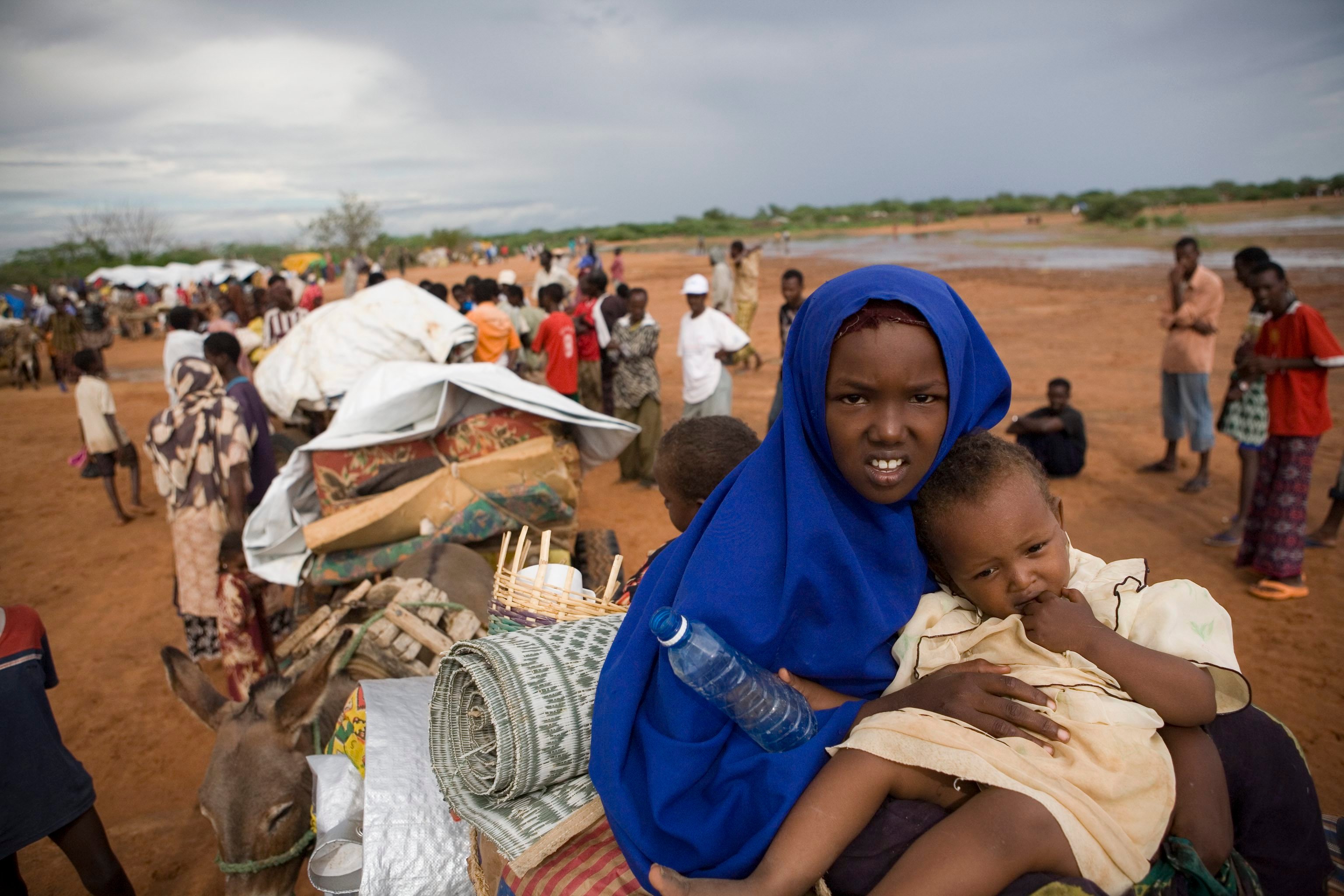As Somali displacement grows, refugee camps report deaths
As Somali displacement grows, refugee camps report deaths
Every day, an average of 1,000 desperate people arrive in Mogadishu seeking help after fleeing famine stricken regions in the South.
Our latest figures show that in July alone, more than 20,000 people have been displaced into Mogadishu in search of assistance. More than half came from Lower Shabelle, one of the regions where famine was declared on Wednesday. Another 2,800 were originated from the Bakool region, whose southern area has also been struck by famine. A further 6,100 people were displaced from the Bay region while almost 1,000 people were displaced from Middle Shabelle.
In response, UNHCR on Wednesday distributed 2,500 emergency assistance packages to internally displaced people in the Dharkenley district of south-west Mogadishu. Delivered through a UNHCR partner, the distribution benefited 15,000 people, identifying and targeting newly-arrived IDPs and vulnerable households such as female-headed families. Each package comprises a UNHCR tarpaulin for shelter, three blankets, a sleeping mat, two jerry cans and a full kitchen set (cooking pots, cutlery etc) and utensils. UNHCR plans to distribute an additional 7,500 packages in the coming weeks.
Throughout Somalia, UNHCR is working to better target aid to the neediest people in areas affected by famine, drought and conflict.
While aid is slowly tricking into Somalia, the outflow of hungry and war-weary refugees is continuing at a high rate. In Kenya's Dadaab camps, we are still receiving about 1,500 new Somali refugees every day, totalling some 60,000 new arrivals so far this year. In total, Kenya has received more than 100,000 Somalis so far this year. In Ethiopia, the Dollo Ado border area is seeing daily arrivals in the hundreds, with over 74,000 arrivals since January. In total, Ethiopia has received a total of nearly 78,000 Somalis so far this year.
More than half of them come from the Gedo, Bay and Bakool areas of south-central Somalia. They say they were either pastoralists or farmers fleeing due to the persistent drought, as well as violence that forced them to abandon their farmlands and livestock.
Many refugees are still arriving in bad shape. Once registered, they are given health screenings. The malnourished and people with medical complications are referred to clinics, including for therapeutic feeding.
Nonetheless, these interventions are sometimes too late. On Tuesday, 15 deaths from malnutrition and other diseases were reported in Dollo Ado's Kobe camp. UNHCR staff in Dadaab are also reporting a rise in the number of deaths due to acute malnutrition, particularly among children.
In Dollo Ado, more than half of the young arrivals are acutely malnourished. While those aged under five are the most vulnerable, UNHCR is also concerned about malnutrition among refugees aged five to 18 years. If treated early and correctly, most malnourished children can recover physically. But the new arrivals with severe acute malnutrition seem to take longer than normal to recover, sometimes up to 6 to 8 weeks. This could be because of the horrendous state they are coming in.
At the Dollo Ado transit centre, UNHCR is providing two hot meals a day for more than 11,000 new arrivals living in makeshift tents. Kobe camp, which opened last month, is already full with over 25,000 refugees. A new camp, Hilaweyn, is nearing completion and will hold up to 60,000 people. We expect to begin moving people from the transit centre within the next two weeks.
Overcrowding is a problem in both Dadaab and Dollo Ado. To ease congestion, UNHCR is continuing its airlift of emergency aid, including tents for more than 75,000 people.
In Kenya, the third of five flights carrying nearly 9,000 family tents from UNHCR stockpiles in Kuwait and Pakistan arrived in Nairobi yesterday afternoon. The cargo was off-loaded onto trucks for the day-long drive by convoy to Dadaab refugee camp near the Kenya-Somalia border. Two more flights are scheduled on Saturday and Monday.
In Ethiopia, the third airlift flight bringing supplies from UNHCR's regional stockpiles in Dubai is expected in Addis Ababa today. Other tents are also coming in by land from neighbouring Djibouti. The tents will go to some 50,000 refugees in the remote Dollo Ado refugee camp on the Ethiopia-Somalia border who are currently in need of shelter. Thirteen UNHCR vehicles are also being flown in.
To date, UNHCR has deployed 60 emergency staff to the region to provide life-saving assistance to the new refugees, with another 11 on the way.
For further information on these topics, please contact:
- In Nairobi UNHCR regional office: Ron Redmond on mobile +254 734 564 019
- In Nairobi UNHCR regional office: Needa Jehu-Hoyah on mobile +254 734 564 018
- In Nairobi UNHCR Kenya office: Emmanuel Nyabera on mobile: +254 773 995 975
- In Dadaab camp, Kenya: William Spindler on mobile +254 720 095 990
- In Kenya, UNHCR Somalia Office: Andy Needham on mobile +254 733 120 931
- In Ethiopia: Milicent Mutuli on mobile +251 911 207 906
- In Ethiopia: Kisut Gebre Egziabher on mobile +251 911 208 901
- In Geneva: Melissa Fleming on mobile +41 79 557 9122




